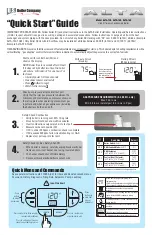
34000 Autry Street, Livonia, MI 48150 | 800.968.5530 | Fax 734.419.0209 | www.hamiltonengineering.com | LIT91127US REV 5/2018
Page 27
VENTING
CAUTION
Flue Gas will condense as it exits the vent termination. This condensate can
freeze on exterior building surfaces which may cause discoloration of these
surfaces. Consideration should be given to the plume of condensation that exits
the exhaust which may affect the cosmetic appearance of the building.
C. INLET AIR VENT
You may use the same material as used for exhaust or any material that is the same diameter that provides a
pressure tight connection. THIS IS ONLY FOR INLET AIR, NOT FOR EXHAUST PIPING!
The air inlet must be a minimum of 12" vertically above the maximum snow level. It is very important that there
are no other vents, chimneys or air inlets in any direction for at least 48".
All venting must be properly supported. The EVO is not intended to support any venting whatsoever.
All
piping, glue, solvents, cleaners, fittings and components, must conform to ASTM (American Society for Testing
and Materials), and ANSI (American National Standards Institute).
D. VENTING RUNS THAT EXCEED MAXIMUM COMBINED LENGTH
If the combined venting length of a heater’s exhaust/inlet air system exceeds the Maximum Combined
Length called out in Table 4-1, Page 21, contact Hamilton Engineering, Inc. for an engineered venting
calculation. Do not proceed without calling Hamilton Engineering, Inc. at 800.968.5530 or 734.419.0200.
VENT CALCULATION EXAMPLE: Installation requires the following material for both inlet and exhaust piping for
the EVO HW 199.1 (maximum combined equivalent length is 100 feet).
Required: 6 Pcs. 90° elbow (6 x 5 = 30 equivalent feet)
= 30 equivalent feet
Required: 20' of Plastic PVC Pipe (20 x 1 = 20 equivalent feet)
= 20 equivalent feet
Required: Inlet air in vertical termination (2) 90° bird screen)
= 11 equivalent feet
Required: Exhaust coupling
= 1 equivalent foot
Total Friction Loss in equivalent feet
= 62 equivalent feet
DANGER
The EVO is not intended to be common vented with any other existing
appliance! Multiple EVO products may be common vented, only if using an
engineered system by Hamilton Engineering, Inc.
E. HEATER REMOVAL FROM AN EXISTING COMMON VENT SYSTEM
At the time of removal of an existing heater, the following steps shall be followed with each appliance that
remains connected to the common venting system placed in operation, while the other appliances that remain
connected to common venting system are not operating.
1. Seal any unused openings in the common venting system. The EVO venting is NOT to be combined
with this older venting system!
2. Visually inspect the venting system for proper size and horizontal pitch to determine if there is
blockage, leakage, corrosion or other deficiencies that could cause an unsafe condition.
THIS VENT SYSTEM IS OK!
















































